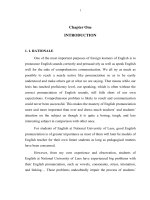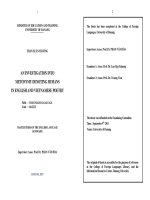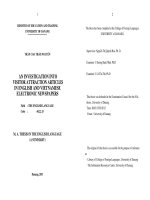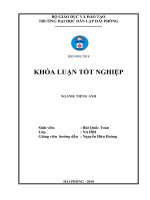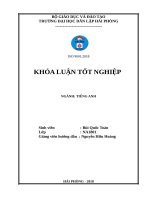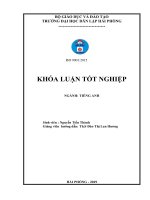AN INVESTIGATION INTO THE PRONUNCIATION ERRORS IN ENGLISH EXPERIENCED BY THE LAOTIAN STUDENTS AT
Bạn đang xem bản rút gọn của tài liệu. Xem và tải ngay bản đầy đủ của tài liệu tại đây (492.49 KB, 71 trang )
1
Chapter One
INTRODUCTION
1. 1. RATIONALE
One of the most important purposes of foreign learners of English is to
pronounce English sounds correctly and persuasively as well as speak English
well for the sake of comprehensive communication. We all try as much as
possible to reach a nearly native like pronunciation so as to be easily
understood and make others get at what we are saying. That means while our
lexis has reached proficiency level, our speaking, which is often without the
correct pronunciation of English sounds, still falls short of our own
expectations. Comprehension problem is likely to result and communication
could never been successful. This makes the mastery of English pronunciation
more and more important than ever and draws much teachers’ and students’
attention on the subject as though it is quite a boring, tough, and less
interesting subject in comparison with other ones.
For students of English at National University of Laos, good English
pronunciation is of greater importance as most of them will later be models of
English teacher for their own future students as long as pedagogical matters
have been concerned.
However, from my own experience and observation, students of
English at National University of Laos have experienced big problems with
their English pronunciation, such as vowels, consonants, stress, intonation,
and linking… These problems undoubtedly impair the process of students’
2
developing
speaking
skills,
especially
their
pronunciation,
their
communicative competence and also, these shortcomings in pronunciation
will inevitably have negative effects on their future students’ language
acquisition and performance.
With this knowledge in mind, we boldly conduct an investigation into
the problems or difficulties that Laotian students may experience in
pronouncing English sounds. We also try to make the problem come to light
with its causes and set forward some helpful teaching activities with a view to
helping these students overcome their problems.
1. 2. AIMS, OBJECTIVES AND QUESTIONS OF THE STUDY
1.2.1. Aim
This study aims at helping Laotian students improve their
pronunciation, especially their performance of English consonants by
suggesting some effective teaching activities for teachers to apply in
classroom environment.
1.2.2. Objectives
The study is intended to fulfil the following objectives:
1. To make a preliminary contrastive analysis between English and Lao
consonant system in terms of phonetic features in the two languages;
2. To detect and identify the common pronunciation errors and
problems that Laotian students may experience in pronouncing English;
3. To suggest effective solutions for the speech improvement of Laotian
students in English.
3
1.2.3. Questions of the study
In this research paper, we focus on the following questions:
1. What are the potential pronunciation errors that Laotian students may
experience when they speak English?
2. What are the causes of the problem?
3. How can Laotian students overcome these possible errors in the
pronunciation of English?
1.3. SCOPE OF THE STUDY
Due to the constraint of time, our study is restricted to common
pronunciation errors that Laotian students at the English Department at the
National University of Laos may have in pronouncing English consonant
sounds and sound clusters.
1.4. ORGANIZATION OF STUDY
Our study will be presented in five chapters as follows.
Chapter one, “Introduction”, includes the rationale, the justification for
the study, the aims and objectives, research questions and the scope of the
study.
Chapter Two, “Literature Review”, is an introduction about the
previous studies on vowels, consonants, syllables. The theoretical knowledge
will consist of a brief review on consonant system of English and Laos in
view of articulatory phonetics. This chapter also discusses the difference
between the phonetic realization of the consonant in the onset and coda of the
syllable structure in English and Laos.
4
Chapter Three, “Research Design and Methodology”, presents the
hypotheses as well as research method, and procedure of data collection and
analysis.
Chapter Four, “Results and Discussion”, is written to describe the
results drawn from the data collected to define what the common errors and
problems in pronunciation that Laotian students may experience are. Besides,
in this chapter the reasons for all the problems will be presented and discussed
in detail.
Chapter Five, “Conclusion and Implications”, draws some conclusions
and the implications related to the study. Finally, the study puts forwards
some limitations and unsolved problems.
5
Chapter Two
LITERATURE REVIEW
2.1.
PRIOR RESEARCH
Historically speaking, Dr. Xayavong (2005) explained that the
currently used Lao language nowadays is derived from the Tai language
family, which was originated in the Altai Mountain Range in the ancient
Mongolia over a thousand years ago [8, p.39].
During the period of 1960s, members of the Lao Committee embodied
for the purpose of surveying and researching associated with the Lao
language. This committee had compiled the first Lao-Lao dictionary of
Viravong in 1961 and the Lao grammar books (Part I (1963) and Part II
(1970)) of the Lao Morphology [cited in 2, p.9-12]. In parallel with using the
Lao language as a medium of instructions in schools, colleges and other
higher educational institutes in both public and private sectors in the Lao PDR
at the present time, the Government has opened up their policies in
cooperation with international communities. As a matter of fact, the demands
on using foreign languages; namely, French, English, German, Russian, etc.,
for communication and cooperation with foreign countries have increasingly
been required in the Lao PDR; especially, in the National University of Laos.
Currently, many foreign languages; especially, the English language is mainly
used in various fields of professions locally and internationally. In this
respect, Faculty of Letters under the direct domination of the National
University of Laos; especially, Department of English has been assigned to
use the English language into a variety of teaching and learning tasks. In other
words, syllabi within Department of English have been divided into different
6
academic subjects and programmes; namely, BA Programme, Special
Programmes, School of Foundation Studies Course, English for other
Faculties, and the MA Programme (Teaching English as a Foreign
Language).
As it is known, the great majority of the Lao BA Programme students
frequently claimed that English is recognised as the second foreign language
for most Lao students. Consequently, the vast majority of the Lao learners of
English have mainly confronted with problems in their learning processes and
the use within their real-life situation. Some of the most significant problems
frequently addressed by the great many teachers and students are commonly
concerned with pronunciation in comparison with the English consonant
sound systems. To exemplify, Dr. Muenmany (2002) argued that most Lao
people have faced problems in pronouncing some European consonant
phonemes; namely, /p/, /f/, /r/, /d/, /l/, /T/ and /D/, among others [3, p.1-3].
Consequently, the above-mentioned difficulties in pronouncing English
consonant phonemes will be linguistically identified into the diagnostically
contrastive analysis of English and Lao consonant sound systems as shown in
section 2.2.
2.2.
THE
DIFFERENCES
BETWEEN
ENGLISH
AND
LAO
PHONETIC SYSTEMS
The rule of English phonetic system is totally different from that of
Laos. English phonetic system is characterized in word stress, sentence stress,
rising and falling intonations, and sounds articulated at the end of the words;
particularly, the final English consonants.
7
As it is known, the Lao phonetic system is based on the pitch of the
sequence tones. Normally, there are no specific emphasis on the utterances;
namely, (1) word stresses and (2) the scarcity of the utterance of the final
consonant sounds, such as the pronunciation of the ‘s’ /s/ occurring in the
final position of any words in the Lao language. According to the Lao
Grammar Book of Vongvichit (1967), there are six tones; namely, mai ek ( '),
mai to ( É ), mai dti (
ÊÊ
) and mai chattawa (
Ë
) [cited in 4, p.19]. In this
respect, the aforementioned Lao Tone Mark aspect is well supported by the
Lao Tone Pitch Chart written by Hoshino and Marcus (1981), which
classified that there are six tones, consisting of three consonant groups [1,
p.158-161]. The chart also shows the code combination of an initial consonant
(i.e., 3 types (kang, tam, sung)) and a final consonant (3 types (stops, nasals
and others)), which describes the code for tone determination when
pronouncing the words [1, p.158-161].
2.2.1 Consonant system in English and Laos
However, according to our observation, it is not tone that causes
problems for Lao students of English. The problem is based on the difference
in the system of consonants in the two languages. To start the comparison
between English consonants and Lao consonants, we would like to sketch a
picture about the consonant chart in each language.
8
Table 2.1 English consonant chart
Place
LabioBilabial Dental
Alveolar
Manner
dental
p
t
Stops vd
b
d
vless
Affricates vd
vless
T
f
s
Fricatives vd
D
v
z
vless
m
n
Nasals
l
Lateral
W
r
Approximants
Palatoalveolar
Palatal Velar Glottal
k
g
tS
dZ
S
Z
?
h
N
j
(w)
Lao Consonant Phonemes
Phonologically speaking, 20 Lao consonant phonemes may be
classified as follows:
– 8 stops ([ph], [th], [kh], [p], [k], [b], [t], [d]),
– 4 fricatives (/f/, /s/, /c/, /h/),
– 4 nasals (/m/, /n /, /∆/, /N/),
– 2 liquids (/l/, /r/), and
– 2 semivowels (/w/, /j/).
9
The Lao Consonant System
Table 2.2 The Lao Consonant Chart
Manner of
articulation
Voiceless
aspirated stops
Voiceless
unaspirated
stops
Voiceless stops
Fricative
Nasals
Liquids
Semi vowels
Place of articulation
Bilabial
Labio
Dentals
Dentals
Palatal
Velar
ph
th
kh
p
t
K
b
d
s
n
l
f
m
w
c
∆
r
j
Glottal
h
N
(Extracted from “The Linguistic Theory” (630LI221) for the SFS – NUOL by Senemany
(2001) [4, p.51])
From the consonant charts of English and Lao, it is noted that English
voiced labio-dental [v] is absent in Lao consonant system whereas the
aspirated members of [p, t, k] are present in Lao with phonemic status. Also,
apart from this, Lao has these consonants as the phonemes in its system - the
palatal fricative [c], palatal nasal [⎟].
The relation between spelling and pronunciation is also a problem to
take into consideration. First, the letter "a" is pronounced “ah” as in “father”,
so the word for “village”, ban, is pronounced “bahn”. Secondly, words with
“o” like “hot” are pronounced “hote”. Lot ("vehicle") is “lote”, and “mot”
("used up") is “mote”. Next, "ph" isn’t “f” but “p” as in English, and finally
"th" is pronounced “t”, not as “th” in English. The single letters "t" and "p" are
used to represent hard consonant sounds that aren’t common in English.
10
As for the consonants of Lao, the following have the same
pronunciation as in English: [b, d, f, h, k, l, m, n, s ]
The following letters have different sounds from English. Two of them
may be difficult for English speakers. These are the hard /p/ sound and the
hard /t/ sound. The first is a cross between "p" and "b" while the second is a
cross between "t" and "d" (like the "t" in "sixty")
Table 2.3 Spelling-Pronunciation relationship in Laos vs English
P
a hard p/b sound
Ph
pronounced as "p" in English
T
a hard t/d sound
Th
pronounced as "t" in English
G
Has a harder sound, a cross between "g" and "k"
J
Has a harder sound than in English
Ng
used at the beginning as well as at the end of words
W
sometimes has a "v" sound
Moreover, there are various pronouncing styles of the regional dialects
from each part of the Lao country as shown below.
In the Vientiane dialect, [c] (like [c] as in “chin” in Vietnamese) and
[k] are sometimes in free variation. This occurs only in informal speech. For
example:
k-c
c-k
= /kin/ vs /cin/ ( eat)
= /cia / vs /kia/ ( paper)
The phoneme /f/ is substituted for the phoneme /p/ in the Savannakhet
dialect. For example:
11
f-p
= /fai /
=/fan/
/pai / ( fire)
/pan/ (cut)
The same variation also occurs in the Pakse dialect.
Furthermore, in the Pakse dialect, / l / and / d / are sometimes in free
variation. For example:
l-d
= / lao/
/dao/ (star). (Like /đ/ in Vietnamese)
In some areas [wa] may be pronounced [ua]. For example, [gwa]
(“more than”) may be pronounced [gua], [kwa] (“right side”) may be [kua],
and [gwang] (“wide”) may be pronounced [guang].
The word used in Laos for “province” - [kwaeng] - may be pronounced
[kaeng] (without the “w”) colloquially.
The second point that should be noted in the contrastive analysis of English
and Lao consonants is the presence of the consonant clusters in the former
and the absence of consonant clusters in the latter. It is argued that there is no
consonant cluster in Lao for the linguistic fact that the product from the
combination of two or more consonants should be the synthetic sound from
the individual componential sounds, as in [tS] of English. This combinative
sound is not a mere sum of the two componential sounds [t] and [j]. The same
thing cannot be said to Lao where the quality of the combinative sounds or
consonant clusters is the same as the second individual component with a
little low level of pitch. Thus it can be said that “consonant cluster” in Lao is
just a name that refers to a quantitative combination of two consonants rather
than a qualitative one. In this sense, we understand that there can be two
kinds of consonant clusters: the genuine one, which is perceived as an
integrated unit, and the pseudo one, which is perceived as two or three
12
consecutive sounds. The English consonant clusters are treated as the former
and those in Lao the latter.
2.2.2 The syllable structure of English and Laos
One more thing that should be taken into consideration is the phonetic
realization of the components in the syllable structure in English and Laos.
2.2.2.1 The nature of the syllables
The syllable is a very important unit, is usually described as consisting
of a centre which has little or no obstruction to airflow and which sounds
comparatively loud; before and after this centre, there will be greater
obstructive to airflow and/or less loud sound as in the following types:
a) A minimum syllables would be a single vowel in isolation, e.g. the
words ‘are’ [a:], ‘or’ [O:], ‘err’ [Z;].
b) Some syllables have an onset, e.g. ‘bar’ [bA;], ‘key’ [ki;].
c) Syllables may have no onset but have a coda, e.g. ‘am’ [&m], ‘ease’
[i;z].
d) Some syllables have onset and coda, e.g. ‘run’ [rVn], ‘sad’ [s&t].
There are still problems with this phonetic description of the syllable,
particularly in the matter of deciding on the division between syllables. One
problem is that by some definitions the‘s’ in the middle, between ‘k’ and‘t’,
would be counted as a syllable, which most English speakers would reject.
However, opinions usually differ as to where the two syllables are to be
divided; the possibilities are (using the symbol + to signify a syllable
boundary): e + kstr@, ek + str@, eks + tr@, ekst + r@, ekstr + @
Usually the second or third possibilities are chosen; it is not possible to
say which of these the correct choice is.
13
The structure of the English syllables consists of an onset. If the first
syllable of the word in question begins with a vowel (any vowel may occur,
though U is rare) that is called initial syllable, if the syllable begins with one
consonant, that initial consonant may be any consonant phoneme except [N],
[Z] is rare. It is noted that syllable have two or more consonants together that
called a consonant cluster.
Initial two-consonant clusters consist of two sorts in English as the‘s’
followed by one of a small set of consonant, e.g. in words ‘sting’ [stIN],
‘sway’[sweI], ‘smoke’[sm@Uk] is called the pre-initial consonant and the
other consonant(t,w,m in the above examples) the initial consonant. These
clusters are shown in Table 2.4.
Table 2.4. Two- consonant clusters with pre-initial‘s’
Preinitia
Initial
l
‘s’ +
p
t
k
spI
stI
skI
n
k
n
b d g
f
- - - sfI
@
T s S h v D z Z
- - - - -
-
- -
m
n
N
sme sn@
U
l
(Extracted from Roach (2000), English Phonetics and Phonology:A practice
course,Cambridge University Press.[27,p.60] )
The other sort begins with one of a set of about 13 consonants,
followed by one of the set l, r, w, j, as in, e.g. ‘play’[pleI ], ‘try’ [trAI],
‘quick’[kwIk], ‘few’[fju;] is called the initial consonant and the second the
post-initial. There are some restrictions on which consonants can occur
together. This can best be shown in Table 2.5. below
14
Table 2.5. the Post consonant clusters with initial ‘s’
Post-initial
‘S’ plus initial
l
r
w
p
splay
spray
spew
t
-
string
stew
k
sclerosis
screen
squeak
j
skewer
(Extracted from Roach (2000), English Phonetics and Phonology:A practice
course,Cambridge University Press.[27,p.59] )
Further, any consonant may be a final consonant except h, r, w, j. there
are two sorts of two-consonant final cluster, one being a final consonant
preceded by a pre-final consonant (such as m, n, N, l, s), e.g. in words ‘bump’
[bVmp], ‘ask’ [A;sk] and the other a final consonant followed by a post-final
consonant (such as s, z, t, d, T), e.g. in words ‘bets’ [bets], ‘beds’ [bedz] .
These post-final consonant can often be identified as separate morphemes
(although not always, e.g. ‘axe’ [&ks] is a single morpheme and its final‘s’
has no separate meaning).
There are two types of final three-consonant clusters; the first is prefinal plus post-final, as in table below:
Table 2.6. final three-consonant clusters: the first is pre-final plus post-final
Pre-final
Final
Post-final
helped
He
l
p
t
banks
N
k
s
bonds
b&
bQ
n
d
z
twelfth
twe
l
f
T
15
(Extracted from Roach (2000), English Phonetics and Phonology:A practice
course,Cambridge University Press.[27,p.60] )
The second type shows that more than one post-final consonant can
occur in a final cluster: final plus post-final 1 plus post final 2. Post- final 2 is
again one of s, z, t, d, T.
Table 2.7. final three-consonant clusters:
final plus post-final 1 plus post final 2
Pre-final
Final
Post-final 1
Post-final 2
fifths
fI
-
f
T
s
next
ne
-
k
S
t
lapsed
l&
-
p
s
t
(Extracted from Roach (2000), English Phonetics and Phonology:A practice
course,Cambridge University Press.[27,p.61] )
Most four-consonant clusters can be analyzed as consisting of a final
consonant preceded by a pre-final and followed by post-final 1 and post-2, as
shown below:
Table 2.8. four-consonant clusters
Pre-final
Final
Post-final 1
Post-final 2
twelfths
twe
l
f
T
s
prompts
pro
m
p
t
s
(Extracted from Roach (2000), English Phonetics and Phonology:A practice
course,Cambridge University Press.[27,p.61] )
A small number of cases seem to require a different analysis, as
consisting of a final consonant with no pre-final but three post-finals:
16
Table 2.9. Four-consonant clusters: zero pre-final + 3 post-finals
Pre-final
Final
Post-final 1
Post-final 2
Post-final 2
sixths
si
-
k
S
T
s
texts
te
-
k
S
t
s
(Extracted from Roach (2000), English Phonetics and Phonology:A practice
course,Cambridge University Press.[27,p.60] )
A concept of syllable structure as well as phonetic realization of this
structure is a subject of considerable interest to phonologists and foreign
learners of English. In the following section, we will present how English
syllable structure is realized as compared with that of Laos.
2.2.2.2. Remarks on the syllable structure of English and Laos
In general, there are more similarities in the syllable structure in
English and Lao than the differences. Like English, Lao also has open and
closed syllable, light and heavy syllable with the onset (O), the Nucleus (N),
the Rhyme (R), the Coda (C)
σ
Onset (O)
Rhyme (R)
Nucleus (N)
spr
I
Coda (C)
n t
Figure 2.1 The internal structure of the syllable in English
17
‘ ---§¾©’ [sa:t] (sạt) ⇒ syllable in Lao
σ
Onset (O)
Rhyme (R)
Nucleus (N)
§
¾
Coda (C)
©
Figure 2.2 The internal structure of the syllable in Lao
As we have mentioned, the components in the syllable structure are
phonetically realized differently in each language. English syllable is
characterized with the articulation of the final consonant in the coda. The
voiceless alveolar stop [t] is usually released in speech with normal speed. In
Lao, the final consonants are not heard and such phonetic features as final
release are not realized. The coda in the syllable structure of Lao is treated as
the component to contribute to the modification or shaping of the quality of
the Rhyme and it is never heard as an individual sound.
Last but not least important is the phonetic realization of the phonemes
of the stop and plosive class / p, t, k, b, d, g / which can have such phonetic
features as [+ aspiration ] or [ - voicing ] in different phonetic contexts. The
presence of the fortis members or lenis members in the Rhyme may contribute
to the modification of the quality of the Nucleus as far as the length of
articulation is concerned.
18
In the previous studies of the differences in English and Lao phonetic
system, the problems that the Laotian students may encounter have been
mentioned. However, the motivation of the errors that Laotian students may
make as well as how these mistakes are distributed among Laotian learners
who speak different dialects of Lao are still unsolved problems.
2.3. SUMMARY
As we have mentioned, due to the fact that English and Lao are
different languages as far as their typology is concerned, it is predicted that
Laotian students of English may make mistakes in pronunciation of English.
These suggested mistakes may come from the differences in system of
consonants in English and Lao as well as the phonetic features that members
of classes of consonants may have in pronunciation. Also, the phonetic
features of the subsyllabic elements in the internal structure of the syllable in
English and Lao can be taken into consideration for a contrastive analysis
with which our assumptions are made about the potential errors that Laotian
students may have in performing their pronunciation of English words.
Finally, the inventory of phonemes in some dialects in Lao is also treated as
the source for the pronunciation mistakes.
19
Chapter Three
RESEARCH DESIGN AND METHODOLOGY
3.1. RESEARCH DESIGN AND METHOD
This study is a qualitative and quantitative research using predictive
contrastive analysis. With this kind of research and method, the study starts
with a preliminary contrastive analysis of sound system in English and Lao,
and then some hypotheses are drawn from the preliminary assumptions about
students’ pronunciation competence. These hypotheses are tested with
qualitative and quantitative result from the data collected from questionnaires
and direct recording.
3.2. HYPOTHESES
With the preliminary information from the comparison between
phonetic system of English and that of Laotian language presented in chapter
Two, the study generates the following hypotheses:
• Due to the fact that there are no Lao counterparts for the English
sounds /z/, /Z/, /v/, /S/, /T/, /D/, /Ù/, /Í/, students may make errors in
pronouncing the individual sounds at both word-initial and final
position;
• Due to the absence of consonant clusters in Laos, Laotian students
may make errors in producing English consonants concerning the
clusters of sound;
• There would be somewhat a logical distribution of common
pronunciation errors made by Laotian students according to their
regional dialects.
20
3.3. METHOD AND PROCEDURE
1. The first step of this research was to review relevant documents,
books, theses, and researches concerning our topic published in Lao, and
other languages.
2. The second step is to make a preliminary contrastive analysis
between English sound system and Lao sound system concerning the
inventory of phonemes and the syllable structure in these two languages.
3. The third step is to identify the similarities and differences between
English pronunciation and Lao pronunciation in terms of segmental units as
individual consonants and consonant clusters in individual words and in
sentences.
4. The fourth step is to generate hypotheses about the errors and
problems that Laotian students may experience in performing English.
5. The fifth step is to collect data from Laotian students. This consists
of two stages conducted as follows.
- At the first stage, Laotian students were required to take part in the
survey with questionnaires. They were given questionnaires with questions
about their province, their level, their attitude about the subjects of their
course and their problems in pronunciation.
- At the second stage, Laotian students as informants were asked to
read or say the words, phrases, sentences that contain problematic sounds.
Their performance was recorded and transcribed normally for the analysis.
The similar sounds and the exotic sounds in the Laotian students’
performance of English were recorded as empirical evidence for further
contrastive analysis.
21
6. The data analysis is expected to yield information about errors and
problems that are mentioned in the hypotheses. They are analysed
qualitatively and quantitatively to yield the evidence for testing the
hypotheses. The occurrence of error of various types are calculated and
tabulated with their frequency in percentage.
3.4. SUBJECT SELECTION AND DESCRIPTION
The subjects involved in the research are the tertiary students of five
levels studying at the English Department at the National University of Lao.
The selection of the informants in this context should include the
representatives of the distinctive dialects in Laos. These subjects are selected
for the study due to the following reasons.
Firstly, there is a suggested distinction between the students who have
studied the phonetics lessons and those have not. At the second years of the
syllabus, Laotian students at BA. Programme is required to attend a phonetic
course with the allocation of 45 periods.
Secondly, as the freshmen, the first year students need to get an
awareness of their mistakes from pronunciation teachers from the early year
to get free from shaping these mistakes into potential “errors”. This is
beneficial for their learning and practicing of English pronunciation in later
years.
Thirdly, the subject chosen from the first year to the fourth year in the
three areas of Laos should serve the purpose of the study: to find out
qualitative and quantitative information about the commitment of
pronunciation mistakes which are distributed among those students who speak
different dialects of Laos.
22
Last but not least, this kind of subject also helps provide some
necessary information about students’ background and attitudes towards
learning and practicing pronunciation, which contributes to the building of the
corpus of study.
3.5. THE SAMPLE
The recordings were administered to a sample of 45 Laotian students.
As mentioned above, the population from which the sample was drawn was
the tertiary students from freshmen to senior level. To get the information
about the distribution of errors of different kinds, we chose students in
different provinces of Laos and these informants were treated as the ones that
provided the representative samples of pronunciation performance. The
students were chosen with convenience, thus this sampling somewhat failed
to maintain the coverage of students of different criteria of evaluation in each
levels of learning such as Excellent, Very good, Good, Quite good and Fair.
For the description of the sampling, please see table 3.1 below:
Table 3.1 The representative informants selected for the diagnostic test
No
1
2
3
4
5
6
7
8
9
10
11
Student’s name
Mr. Anousack
Mr. Saikham
Mr. Sateiny
Ms. Vilayphone
Ms. Vidavone
Mr. Onnith
Mr. Chongxong
Mr. Thongsy
Mr. Bounlan
Mr. Pouxay
Mr. Phonesavan
From
City
Luangphabang
Xiengkhouang
Xayyabouly
Xayyabouly
Huaphanh
Luangnamtha
Xiengkhouang
Luangnamtha
Phongsaly
Huapanh
Oudomxay
Class / year
Region
North
North
North
North
North
North
North
North
North
North
North
1
1
1
2
3
4
4
5
5
5
5
23
12
13
14
15
16
17
18
19
20
21
22
23
24
25
26
27
28
29
30
31
32
33
34
35
36
37
38
39
40
41
42
43
44
45
Mr. Phouxay
Mr. Thongvan
Mr. Pouxay
Ms. Mavan
Mr. Soneny
Ms. Ammalay
Ms. Nittaya
Mr. Phonethavong
Mr. Manivanthao
Ms. Dalavong
Mr. Leokham
Mr. Sisavath
Mr. Sengaloun
Mr. Souvankham
Mr. Anousit
Mr. Latsamee
Mr. Yersiang
Ms. Thidachanh
Ms. Oulayvanh
Ms. Soudchay
Ms. Dalivanh
Ms. Somsanith
Ms. Phonekeo
Mr. Somsoueng
Ms.Chitanaphone
Mr. Mangkone
Ms.Sompadthana
Ms.Phousavan
Ms.Phoudthasone
Mr. Vilaysack
Mr.Siliphone
Mr. Manivone
Mr. Somphone
Ms.Phonesouk
Huaphanh
Luangphabang
Luangphabang
Luangphabang
Xiengkhouang
Vientiane
Vientiane
Vientiane
Vientiane
Vientiane
Vientiane
Vientiane
Vientiane
Vientiane
Vientiane
Vientiane
Vientiane
Vientiane
Vientiane
Vientiane
Vientiane
Vientiane
Vientiane
Boulikhamxay
Savannakheth
Boulikhamxay
Champasack
Champasack
Champasack
Champasack
Champasack
Champasack
Savannakheth
Savannakheth
North
North
North
North
North
Central
Central
Central
Central
Central
Central
Central
Central
Central
Central
Central
Central
Central
Central
Central
Central
Central
Central
South
South
South
South
South
South
South
South
South
South
South
5
5
5
5
5
1
1
1
1
2
2
4
4
4
4
5
5
5
5
5
5
5
5
1
1
2
3
3
4
4
4
5
5
5
24
3.6. METHOD OF DATA COLLECTION
The data was obtained using 2 measurement instruments: survey with
questionnaires and diagnostic test.
The questionnaires were issued to the population of 100 students in the
English Department of National University of Laos. To facilitate the survey,
the researcher made clear all the questions posed to students to get rid of
students’ confusion with the instructions in the questionnaires. The students
were also allotted some time to make up their mind on the choice of options
or to give their feedback to open-ended questions. (See Appendix A for the
design of the questionnaire.)
The diagnostic test consisted of 2 parts. Part 1 was designed for testing
the students’ perception of the consonants and consonants clusters in
question. This part consisted 11 pairs of sentences, each of which contained
consonants in initial and final position in words, which were intended to cause
potential problems.
Part 2 of the diagnostic test consisted of 3 sections designed for testing
the students’ actual performance of producing sounds. Section 1 contained a
word list to test students’ performance of English consonants in syllableinitial position or in syllable-final position in isolated words. Section 2
contained a word list to test their performance in consonant clusters at
different positions in monosyllabic words and polysyllabic words. Section 3
contained a sentence list to test their performance of the consonants and
consonant clusters in question in connected speech. 45 students as
representative informants of the three regions of Laos concerning their
distinctive style of dialect were chosen to involve in the diagnostic test.
25
The word list in Section 1 Part 2 consists of 52 words with 26 words
containing consonants at initial position and 26 others containing consonants
at final position. The word list in Section 2 itself consists of 22 words that
came in 11 pairs containing consonant clusters. The fact that words came in
pairs with the same consonant cluster was considered as to make sure that the
students made the same mistake. The sentence list in section 3 consists of 13
sentences containing the consonants and consonant clusters in question.
The procedure of word selection was as follows. All the words were
collected from the book Sound English which is reliable for the inventory of
words containing the sounds in question and which is available for the
students at Laos. For each part of the test, the students were asked to read
aloud the words and sentences so that the recording could be made.
The problems that were issued in the two parts of the diagnostic test are
presented here in table 3.2 below:
Table 3.2 Problems of English consonants in Laotian students’ performance
Problems
Members
Context
Bilabial Stops
[p, b]
initial, final
Alveolar stop
[t, d]
initial, final
Dental fricative
[T, D]
initial, final
Labio-dental stop
[f, v]
initial, final
Alveolar fricative
[z, S]
initial, final
Palato-alveolar fricative
[tS, dZ, Z]
initial, final
Alveolar approximant
[l, r]
initial, final
Bilabial approximant
[w]
initial, W-medial
2-consonant cluster
[tr, dr, kr, Tr , kw, kl, sp]
initial, W-medial
3-consonant cluster
[skr, str, spr, spl]
initial, W-medial
Number
